Advances in Electrochemical Biosensor Technologies for the Detection of Nucleic Acid Breast Cancer Biomarkers
Abstract
:1. Introduction
2. Electrochemical Biosensors for miRNA Analysis
| Biomarker Analyte | Biosensor Design | Redox Probe | Technique | Linear Range | LOD | Ref. |
|---|---|---|---|---|---|---|
| miRNA | ||||||
| miR-21 | ITO/PET/hydrogel-ssDNA | Fc | DPV | 1.0 × 10−8–5.0 × 10−5 M | 5.0 × 10−9 M | [62] |
| SPCE/rGOs/Au NPs/SH-ssDNA; Fc-Au NPs-ssDNA | Fc | DPV | 1.0 × 10−14–2.0 × 10−12 M | 5.0 × 10−15 M | [65] | |
| Au/PNA21, PNA155; Fc-CHA21, Mb-CHA155 detection | Fc | SWV | 1.0 × 10−14–5.0 × 10−9 M | 2.4 × 10−15 M | [66] | |
| PGE/CB-Au NPs/ssDNA | Mb | DPV | 2.9 × 10−15–7.0 × 10−7 M | 1.0 × 10−15 M | [46] | |
| Au/chitosan/ssDNA origami | Mb | DPV | 1.0 × 10−13–1.0 × 10−8 M | 8.0 × 10−14 M | [64] | |
| Au/LNA-TWJ | Mb, TCEP | ACV | 1.0 × 10−16–1.0 × 10−10 M | 7.7 × 10−17 M | [67] | |
| PGE/PPy/ssDNA | MDB | DPV | ––– | 1.7 × 10−10 M | [47] | |
| Au/Au NPs-PPy/ssDNA | TB | DPV | 1.0 × 10−16–1.0 × 10−9 M | 7.8 × 10−17 M | [68] | |
| SPCE/Au NPs/ssDNA | K3[Fe(CN)6], [Ru(NH3)6]Cl3 | SWV | 1.0 × 10−15–1.0 × 10−11 M | 4.0 × 10−16 M | [69] | |
| GCE/Au NPs/DNA | Ag NPs | LSV | 1.0 × 10−16–5.0 × 10−14 M. | 2.0 × 10−17 M | [70] | |
| GCE/SA/ssDNA | [Fe(II)(CN)6]4−/Fe(III)(CN)6]3− | EIS | 1.0 × 10−14–1.0 × 10−8 M | 2.0 × 10−14 M | [71] | |
| GCE/HP1, HP2, DG-TIS | [Fe(II)(CN)6]4−/Fe(III)(CN)6]3− | DPV | 5.0 × 10−14–5.0 × 10−7 M | 3.5 × 10−14 M | [63] | |
| SPCE/Au NPs/ssDNA | HRP | SWV | 1.9 × 10−5–1.0 × 10−1 M | 1.9 × 10−14 M | [72] | |
| μPAD/Au NRs | CeO2-Au@GOx | DPV | 1.0 × 10−15–1.0 × 10−12 M | 4.3 × 10−16 M | [52] | |
| GCE/MoS2-Thi-Au NPs/ssDNA | MoS2-Thi-Au NPs | SWV | 1.0 × 10−12–1.0 × 10−8 M | 2.6 × 10−13 M | [73] | |
| Au/SWCNs/NDs/ssDNA-HCR-hemin/GQ DNAzyme | ––– | DPV | 1.0 × 10−14–1.0 × 10−9 M | 2.0 × 10−15 M | [48] | |
| GCE/rGO/β-CD/HP-DNAzyme | Fc | DPV | 1.0 × 10−15−1.0 × 10−10 M | 1.8 × 10−15 M | [74] | |
| Au/HCP1-HCP2, ssDNA1/Fe3O4 NPs/Thi, ssDNA2/Fe3O4 NPs/Fc, HCR | Thi, Fc | DPV | –– | 4.6 × 10−16 M | [75] | |
| miR-155 | CPE/Fe3O4NPs@Ag/NH2-ssDNA | RSV | DPV | 5.0 × 10−16 –1.0 × 10−9 g/mL | 1.5 × 10−16 g/mL | [45] |
| GCE/GO/Au NRs/SH-ssDNA | OB | DPV | 2.0 × 10−15–8.0 × 10−12 M | 6.0 × 10−14 M | [51] | |
| GCE/Fe-Ni@rGO/QD-Ag, Au NS/SH-ssDNA | hematoxylin | DPV | 5.0 × 10−20–5.0 × 10−11 M | 2.0 × 10−17 M | [54] | |
| GCE/MWCNTs/PtNPs/DNA, CHA, PSC@Au NPs-ALP, NPP | PMo12O403− | DPV | 1.0 × 10−14–1.0 × 10−9 M | 1.6 × 10−15 M | [44] | |
| Au/PNA21, PNA155—CHA | Mb | SWV | 5.0 × 10−14–5.0 × 10−8 M | 1.1 × 10−14 M | [66] | |
| Au/ssDNA-GQDs | HRP | A | 1.0 × 10−15–1.0 × 10−13 M | 1.4 × 10−16 M | [58] | |
| GCE; LCR, MB–CP1CP2; PbS-QDs, CdS-QDs | PbS-QDs, CdS-QDs | SWV | 5.0 × 10−14–3.0 × 10−11 M | 1.2 × 10−14 M | [76] | |
| miR-24 | GCE/MWCNT-PAMAM/ssDNA | Mb | DPV | 1.0 × 10−14–1.0 × 10−7 M | 5.0 × 10−16 M | [59] |
| GCE/PANI-PA/ssDNA | ––– | DPV | 1.0 × 10−15–1.0 × 10−12 M | 3.4 × 10−16 M | [61] | |
| miR-122 | Au/Au NPs/rGO/SH-ssDNA | [Fe(II)(CN)6]4−/Fe(III)(CN)6]3− | DPV | 1.0 × 10−11–1.0 × 10−5 M | 1.7 × 10−12 M | [77] |
| SPGE/ssDNA | ––– | DPV | ––– | 5.0 × 10−9 M | [78] | |
| miR-34a | PGE/ssDNA | [Co(phen)33+] | DPV | 1.4 × 10−7–4.3 × 10−7 M | 8.4 × 10−8 M | [79] |
| CA-IL-PGE/ssDNA | ––– | DPV | 2.0 × 10−3–10 × 10−2 g L−1 | 1.3 × 10−7 M (8.8 × 10−4 g L−1) | [80] | |
| GO-PGE/ssDNA | ––– | DPV | 1.0 × 10−2–4.0 × 10−2 g L−1 | 7.0 × 10−7 (5.0 × 10−3 g L−1) | [56] | |
| miR-522 | HMDE/ssDNA-MB | Os(VI)bipy | DPV | 1.0 × 10−8–2.0 × 10−7 M | –– | [81] |
| HDME/ssDNA | Os(VI)bipy | DPV | 2.0 × 10−9–4.0 × 10−8 M | 2.0 × 10−9 M | [82] | |
| miR-141 | Au/rGE/CNTs/ssDNA; ELISA-like amplification | HRP | SWV | 1.0 × 10−14–1.0 × 10−9 M | 1.0 × 10−14 M | [57] |
| GCE/poly(JUGco-JUGA) | ––– | SWV | 5.0 × 10−13–1.0 × 10−10 M | 6.5 × 10−13 M | [60] | |
| Au/HCP1-HCP2, ssDNA1/Fe3O4 NPs/Thi, ssDNA2/Fe3O4 NPs/Fc, HCR | Thi, Fc | DPV | –– | 4.4 × 10−16 M | [75] | |
| miR-27b | GCE; LCR, MB–CP1CP2; PbS-QDs, CdS-QDs | PbS-QDs, CdS-QDs | SWV | 5.0 × 10−14 –1.1 × 10−9 M | 3.1 × 10−14 M | [76] |
| miR-103 | GCE/Au NPs/JUGMHA/NH2-ssDNA | SWV | 1.0 × 10−8–5 × 10−9 M | 1.0 × 10−13 M | [49] | |
| let-7 | Au/GQ-DNA-CHA-hemin/GQ DNAzyme | ––– | DPV | 1.0 × 10−15–1.0 × 10−9 M | 4.6 × 10−16 M | [83] |
| BRCA1 | ||||||
| BRCA1 | Au/MCH/PNA | Fc-PBA | SWV | 1.0 × 10−14–1.0 × 10−8 M | 2.9 × 10−15 M | [84] |
| GCE/PEDOT/PEP | MB | DPV | 1.0 × 10−14–1.0 × 10−9 M | 3.4 × 10−15 M | [85] | |
| Au/Cys/Glu/Fc-PAMAMs/ssDNA; | Fc-PAMAM | DPV | 1.3 × 10−9–2.0 × 10−8 M | 4.0 × 10−10 M | [86] | |
| GCE/GO-CB [7]; Fc Au NS/T-DNA/HRP-Au NSs | HRP | DPV | 1.0 × 10−7–5.0 × 10−11 M | 2.5 × 10−11 M | [87] | |
| GCE/P[(DA-β-CD)/CTAB-Ag NPs]/MCM−41-SO3H | HRP | SWV | 6.3 × 10−10–2.0 × 10−9 g L−1 | –– | [88] | |
| GCE/P[(DA-β-CD)/CTAB-Ag NPs]/MCM-41-SO3H | HRP | DPV | 1.6 × 10−11–1.0 × 10−8 g L−1 | –– | [88] | |
| Au/cDNA/MCH/CESA/3-QD@DNA NC | ––– | DPV | 5.0 × 10−18–5.0 × 10−15 M | 1.2 × 10−18 M | [89] | |
| SPE/TDNA/BSA/polyA Au NPs-ssDNA;Biotin-BRCA1/SA-HPR; SH-TMB/H2O2 | ––– | CV; A | 1.0 × 10−15–1.0 × 10−9 M | 1.0 × 10−16 M | [90] | |
| GCE/rGO/MWCNTs/PANHS/ssDNA | ––– | EIS | 1.0 × 10−18–1.0 × 10−10 mol L−1 | 3.5 × 10−19 mol L−1 | [91] | |
| GCE/MWCNTs/PANHS/ssDNA | ––– | EIS | 1.0 × 10−17–1.0 × 10−10 mol L−1 | 3.1 × 10−18 mol L−1 | [91] | |
| GCE//PANHS/ssDNA | ––– | EIS | 1.0 × 10−16–1.0 × 10−10 mol L−1 | 3.7 × 10−17 mol L−1 | [91] | |
| GCE/PEG/ssDNA | ––– | EIS | 5.0 × 10−14–1.0 × 10−9 M | 1.7 × 10−15 M | [92] | |
| ITO/CHIT-co-PANI/ssDNA | ––– | EIS | 5.0 × 10−17–2.5 × 10−14 M | 5.0 × 10− 17 M | [93] | |
| Au/SH-ssDNA | ––– | EIS | 1.0 × 10−19–1.0 × 10−7 M | 4.6 × 10−20 M | [94] | |
| GCE/PEG/Fe(III)-TA)/pDA; Au NPs | ––– | EIS | 1.0 × 10−16–1.0 × 10−11 M | 5.0 × 10−17 M | [95] | |
2.1. Electrochemical Biosensors Based on Redox Mediators
2.1.1. Biosensor Based on Redox Molecules
2.1.2. Biosensors Based on Enzymes
2.1.3. Biosensors Based on Electrochemical Indicator–Functionalized Nanomaterials
2.1.4. Biosensors Based on Conducting Polymers
2.2. Label-Free Electrochemical Biosensors
2.2.1. Biosensors Based on the Detection of Guanine Residues
2.2.2. Biosensors Based on Hemin/GQ DNAzymes
3. Electrochemical Biosensors for BRCA1 Analysis
4. Conclusions
Funding
Institutional Review Board Statement
Informed Consent Statement
Data Availability Statement
Conflicts of Interest
References
- McKinney, S.M.; Sieniek, M.; Godbole, V.; Godwin, J.; Antropova, N.; Ashrafian, H.; Back, T.; Chesus, M.; Corrado, G.C.; Darzi, A.; et al. International evaluation of an AI system for breast cancer screening. Nature 2020, 577, 89–94. [Google Scholar] [CrossRef] [PubMed]
- Li, L.; Liu, Z.P. Detecting prognostic biomarkers of breast cancer by regularized Cox proportional hazards models. J. Transl. Med. 2021, 19, 514. [Google Scholar] [CrossRef]
- Afzal, S.; Hassan, M.; Ullah, S.; Abbas, H.; Tawakkal, F.; Khan, M.A. Breast cancer: Discovery of novel diagnostic biomarkers, drug resistance, and therapeutic implications. Front. Mol. Biosci. 2022, 9, 783450. [Google Scholar] [CrossRef]
- Oliveira-Brett, A.M.; Paquim, A.M.C.; Diculescu, V.C.; Piedade, J.A.P. Electrochemistry of nanoscale DNA surface films on carbon. Med. Eng. Phys. 2006, 28, 963–970. [Google Scholar] [CrossRef] [PubMed]
- Chiorcea-Paquim, A.M.; Oliveira Brett, A.M. Procedure 28 Atomic force microscopy characterization of a DNA electrochemical biosensor. In Comprehensive Analytical Chemistry; Elsevier: Amsterdam, The Netherlands, 2007; Volume 49, pp. 203–205. ISBN 9780444530530. [Google Scholar] [CrossRef]
- Oliveira Brett, A.M.; Diculescu, V.C.; Chiorcea Paquim, A.-M.; Serrano, S.H.P.; Chiorcea-Paquim, A.M.; Serrano, S.H.P. Chapter 20 DNA-electrochemical biosensors for investigating DNA damage. In Comprehensive Analytical Chemistry; Elsevier: Amsterdam, The Netherlands, 2007; Volume 49, pp. 413–437. ISBN 9780444530530. [Google Scholar] [CrossRef]
- Diculescu, V.C.; Chiorcea Paquim, A.-M.; Oliveira Brett, A.M. Electrochemical DNA sensors for detection of DNA damage. Sensors 2005, 5, 377–393. [Google Scholar] [CrossRef]
- Diculescu, V.C.; Chiorcea-Paquim, A.-M.; Oliveira-Brett, A.M. Applications of a DNA-electrochemical biosensor. TrAC Trends Anal. Chem. 2016, 79, 23–36. [Google Scholar] [CrossRef]
- Oliveira, S.C.B.; Diculescu, V.C.; Chiorcea Paquim, A.M.; Oliveira-Brett, A.M. Electrochemical biosensors for DNA-drug interactions. In Encyclopedia of Interfacial Chemistry: Surface Science and Electrochemistry; Elsevier: Amsterdam, The Netherlands, 2018; pp. 124–139. ISBN 9780128098943. [Google Scholar] [CrossRef]
- Chiorcea-Paquim, A.-M.; Oliveira, S.C.; Diculescu, V.C.; Oliveira-Brett, A.M. Applications of DNA-electrochemical biosensors in cancer research. In Comprehensive Analytical Chemistry; Barcelo, D., Hansen, P.-D., Palchetti, I., Eds.; Elsevier: Amsterdam, The Netherlands, 2017; Volume 77, Chapter 9; pp. 287–336. ISBN 9780444639462. [Google Scholar] [CrossRef]
- Feng, T.; Wang, Y.; Qiao, X. Recent advances of carbon nanotubes-based electrochemical immunosensors for the detection of protein cancer biomarkers. Electroanalysis 2017, 29, 662–675. [Google Scholar] [CrossRef]
- Chikkaveeraiah, B.V.; Bhirde, A.A.; Morgan, N.Y.; Eden, H.S.; Chen, X. Electrochemical immunosensors for detection of cancer protein biomarkers. ACS Nano 2012, 6, 6546–6561. [Google Scholar] [CrossRef]
- Yang, L.; Yin, X.; An, B.; Li, F. Precise capture and direct quantification of tumor exosomes via a highly efficient dual-aptamer recognition-assisted ratiometric immobilization-free electrochemical strategy. Anal. Chem. 2021, 93, 1709–1716. [Google Scholar] [CrossRef]
- Yin, X.; Hou, T.; Huang, B.; Yang, L.; Li, F. Aptamer recognition-trigged label-free homogeneous electrochemical strategy for an ultrasensitive cancer-derived exosome assay. Chem. Commun. 2019, 55, 13705–13708. [Google Scholar] [CrossRef]
- Cui, F.; Zhou, Z.; Zhou, H.S. Review—Measurement and analysis of cancer biomarkers based on electrochemical biosensors. J. Electrochem. Soc. 2020, 167, 037525. [Google Scholar] [CrossRef]
- Schwarzenbach, H. Circulating nucleic acids as biomarkers in breast cancer. Breast Cancer Res. 2013, 15, 211. [Google Scholar] [CrossRef] [PubMed]
- Mahesh, G.; Biswas, R. MicroRNA-155: A master regulator of inflammation. J. Interf. Cytokine Res. 2019, 39, 321–330. [Google Scholar] [CrossRef]
- Sundarbose, K.; Kartha, R.V.; Subramanian, S. MicroRNAs as biomarkers in cancer. Diagnostics 2013, 3, 84–104. [Google Scholar] [CrossRef] [PubMed]
- Tran, H.V.; Piro, B. Recent trends in application of nanomaterials for the development of electrochemical microRNA biosensors. Microchim. Acta 2021, 188, 128. [Google Scholar] [CrossRef] [PubMed]
- Chiorcea-Paquim, A.M.; Oliveira-Brett, A.M. Amyloid beta peptides electrochemistry: A review. Curr. Opin. Electrochem. 2022, 31, 100837. [Google Scholar] [CrossRef]
- Li, H.; Li, F.; Wu, J.; Yang, Q.; Li, Q. Two-dimensional MnO2 nanozyme-mediated homogeneous electrochemical detection of organophosphate pesticides without the interference of H2O2 and color. Anal. Chem. 2021, 93, 4084–4091. [Google Scholar] [CrossRef]
- Liu, X.; Li, X.; Gao, X.; Ge, L.; Sun, X.; Li, F. A universal paper-based electrochemical sensor for zero-background assay of diverse biomarkers. ACS Appl. Mater. Interfaces 2019, 11, 15381–15388. [Google Scholar] [CrossRef]
- Chiorcea-Paquim, A.M.; Enache, T.A.; De Souza Gil, E.; Oliveira-Brett, A.M. Natural phenolic antioxidants electrochemistry: Towards a new food science methodology. Compr. Rev. Food Sci. Food Saf. 2020, 19, 1680–1726. [Google Scholar] [CrossRef]
- Enache, T.A.; Chiorcea-Paquim, A.-M.; Fatibello-Filho, O.; Oliveira-Brett, A.M. Hydroxyl radicals electrochemically generated in situ on a boron-doped diamond electrode. Electrochem. Commun. 2009, 11, 1342–1345. [Google Scholar] [CrossRef]
- Chang, J.; Lv, W.; Li, Q.; Li, H.; Li, F. One-step synthesis of methylene blue-encapsulated zeolitic imidazolate framework for dual-signal fluorescent and homogeneous electrochemical biosensing. Anal. Chem. 2020, 92, 8959–8964. [Google Scholar] [CrossRef] [PubMed]
- Pashchenko, O.; Shelby, T.; Banerjee, T.; Santra, S. A comparison of optical, electrochemical, magnetic, and colorimetric point-of-care biosensors for infectious disease diagnosis. ACS Infect. Dis. 2018, 4, 1162–1178. [Google Scholar] [CrossRef] [PubMed]
- Oliveira-Brett, A.M.; Diculescu, V.C.; Enache, T.A.; Fernandes, I.P.G.; Chiorcea-Paquim, A.M.; Oliveira, S.C.B. Bioelectrochemistry for sensing amino acids, peptides, proteins and DNA interactions. Curr. Opin. Electrochem. 2019, 14, 173–179. [Google Scholar] [CrossRef]
- Chiorcea-Paquim, A.M.; Oliveira-Brett, A.M. Nanostructured material–based electrochemical sensing of oxidative DNA damage biomarkers 8-oxoguanine and 8-oxodeoxyguanosine: A comprehensive review. Microchim. Acta 2021, 188, 58. [Google Scholar] [CrossRef] [PubMed]
- Chiorcea-Paquim, A.M.; Oliveira-Brett, A.M. DNA electrochemical biosensors for in situ probing of pharmaceutical drug oxidative DNA damage. Sensors 2021, 21, 1125. [Google Scholar] [CrossRef] [PubMed]
- Chiorcea-Paquim, A.M. 8-oxoguanine and 8-oxodeoxyguanosine biomarkers of oxidative DNA damage: A review on HPLC–ECD determination. Molecules 2022, 27, 1620. [Google Scholar] [CrossRef]
- Zhang, Y.Y.; Guillon, F.X.; Griveau, S.; Bedioui, F.; Lazerges, M.; Slim, C. Evolution of nucleic acids biosensors detection limit III. Anal. Bioanal. Chem. 2022, 414, 943–968. [Google Scholar] [CrossRef]
- Shabaninejad, Z.; Yousefi, F.; Movahedpour, A.; Ghasemi, Y.; Dokanehiifard, S.; Rezaei, S.; Aryan, R.; Savardashtaki, A.; Mirzaei, H. Electrochemical-based biosensors for microRNA detection: Nanotechnology comes into view. Anal. Biochem. 2019, 581, 113349. [Google Scholar] [CrossRef]
- Mahato, K.; Kumar, A.; Maurya, P.K.; Chandra, P. Shifting paradigm of cancer diagnoses in clinically relevant samples based on miniaturized electrochemical nanobiosensors and microfluidic devices. Biosens. Bioelectron. 2018, 100, 411–428. [Google Scholar] [CrossRef]
- Labuda, J.; Oliveira Brett, A.M.; Evtugyn, G.; Fojta, M.; Mascini, M.; Ozsoz, M.; Palchetti, I.; Paleček, E.; Wang, J. Electrochemical nucleic acid-based biosensors: Concepts, terms, and methodology (IUPAC Technical Report). Pure Appl. Chem. 2010, 82, 1161–1187. [Google Scholar] [CrossRef]
- Corduneanu, O.; Chiorcea-Paquim, A.-M.; Diculescu, V.; Fiuza, S.M.; Marques, M.P.M.; Oliveira-Brett, A.M. DNA interaction with palladium chelates of biogenic polyamines using atomic force microscopy and voltammetric characterization. Anal. Chem. 2010, 82, 1245–1252. [Google Scholar] [CrossRef] [PubMed]
- Pontinha, A.D.R.; Jorge, S.M.A.; Chiorcea Paquim, A.M.; Diculescu, V.C.; Oliveira-Brett, A.M. In situ evaluation of anticancer drug methotrexate-DNA interaction using a DNA-electrochemical biosensor and AFM characterization. Phys. Chem. Chem. Phys. 2011, 13, 5227–5234. [Google Scholar] [CrossRef] [PubMed]
- Chiorcea-Paquim, A.-M.; Pontinha, A.D.R.; Eritja, R.; Lucarelli, G.; Sparapani, S.; Neidle, S.; Oliveira-Brett, A.M. Atomic force microscopy and voltammetric investigation of quadruplex formation between a triazole-acridine conjugate and guanine-containing repeat DNA sequences. Anal. Chem. 2015, 87, 6141–6149. [Google Scholar] [CrossRef] [PubMed]
- Diculescu, V.C.; Chiorcea-Paquim, A.-M.; Eritja, R.; Oliveira-Brett, A.M. Evaluation of the structure–activity relationship of thrombin with thrombin binding aptamers by voltammetry and atomic force microscopy. J. Electroanal. Chem. 2011, 656, 159–166. [Google Scholar] [CrossRef]
- Chiorcea-Paquim, A.-M.; Santos, P.V.; Eritja, R.; Oliveira-Brett, A.M. Self-assembled G-quadruplex nanostructures: AFM and voltammetric characterization. Phys. Chem. Chem. Phys. 2013, 15, 9117–9124. [Google Scholar] [CrossRef]
- Chiorcea-Paquim, A.-M.; Corduneanu, O.; Oliveira, S.C.B.; Diculescu, V.C.; Oliveira-Brett, A.M. Electrochemical and AFM evaluation of hazard compounds–DNA interaction. Electrochim. Acta 2009, 54, 1978–1985. [Google Scholar] [CrossRef]
- El Aamri, M.; Yammouri, G.; Mohammadi, H.; Amine, A.; Korri-Youssoufi, H. Electrochemical biosensors for detection of microRNA as a cancer biomarker: Pros and cons. Biosensors 2020, 10, 186. [Google Scholar] [CrossRef]
- Chen, C.D.; La, M.; Zhou, B. Bin Strategies for designing of electrochemical MicroRNA genesensors based on the difference in the structure of RNA and DNA. Int. J. Electrochem. Sci. 2014, 9, 7228–7238. [Google Scholar]
- Coutinho, C.; Somoza, Á. MicroRNA sensors based on gold nanoparticles. Anal. Bioanal. Chem. 2019, 411, 1807–1824. [Google Scholar] [CrossRef]
- Cai, W.; Xie, S.; Tang, Y.; Chai, Y.; Yuan, R.; Zhang, J. A label-free electrochemical biosensor for microRNA detection based on catalytic hairpin assembly and in situ formation of molybdophosphate. Talanta 2017, 163, 65–71. [Google Scholar] [CrossRef]
- Yazdanparast, S.; Benvidi, A.; Azimzadeh, M.; Tezerjani, M.D.; Ghaani, M.R. Experimental and theoretical study for miR-155 detection through resveratrol interaction with nucleic acids using magnetic core-shell nanoparticles. Microchim. Acta 2020, 187, 479. [Google Scholar] [CrossRef]
- Yammouri, G.; Mohammadi, H.; Amine, A. A highly sensitive electrochemical biosensor based on carbon black and gold nanoparticles modified pencil graphite electrode for microRNA-21 detection. Chem. Afr. 2019, 2, 291–300. [Google Scholar] [CrossRef]
- Kaplan, M.; Kilic, T.; Guler, G.; Mandli, J.; Amine, A.; Ozsoz, M. A novel method for sensitive microRNA detection: Electropolymerization based doping. Biosens. Bioelectron. 2017, 92, 770–778. [Google Scholar] [CrossRef] [PubMed]
- Liu, L.; Song, C.; Zhang, Z.; Yang, J.; Zhou, L.; Zhang, X.; Xie, G. Ultrasensitive electrochemical detection of microRNA-21 combining layered nanostructure of oxidized single-walled carbon nanotubes and nanodiamonds by hybridization chain reaction. Biosens. Bioelectron. 2015, 70, 351–357. [Google Scholar] [CrossRef] [PubMed]
- Tran, H.V.; Nguyen, N.D.; Piro, B.; Tran, L.T. Fabrication of a quinone containing layer on gold nanoparticles directed to a label-free and reagentless electrochemical miRNA sensor. Anal. Methods 2017, 9, 2696–2702. [Google Scholar] [CrossRef]
- Bai, Y.Y.; Wu, Z.; Xu, C.M.; Zhang, L.; Feng, J.; Pang, D.W.; Zhang, Z.L. One-to-many single entity electrochemistry biosensing for ultrasensitive detection of microrna. Anal. Chem. 2020, 92, 853–858. [Google Scholar] [CrossRef]
- Azimzadeh, M.; Rahaie, M.; Nasirizadeh, N.; Ashtari, K.; Naderi-Manesh, H. An electrochemical nanobiosensor for plasma miRNA-155, based on graphene oxide and gold nanorod, for early detection of breast cancer. Biosens. Bioelectron. 2016, 77, 99–106. [Google Scholar] [CrossRef]
- Sun, X.; Wang, H.; Jian, Y.; Lan, F.; Zhang, L.; Liu, H.; Ge, S.; Yu, J. Ultrasensitive microfluidic paper-based electrochemical/visual biosensor based on spherical-like cerium dioxide catalyst for miR-21 detection. Biosens. Bioelectron. 2018, 105, 218–225. [Google Scholar] [CrossRef]
- Su, S.; Wu, Y.; Zhu, D.; Chao, J.; Liu, X.; Wan, Y.; Su, Y.; Zuo, X.; Fan, C.; Wang, L. On-electrode synthesis of shape-controlled hierarchical flower-like Gold nanostructures for efficient interfacial DNA assembly and sensitive electrochemical sensing of microRNA. Small 2016, 12, 3794–3801. [Google Scholar] [CrossRef]
- Khosravi, F.; Rahaie, M.; Ghaani, M.R.; Azimzadeh, M.; Mostafavi, E. Ultrasensitive electrochemical miR-155 nanocomposite biosensor based on functionalized/conjugated graphene materials and gold nanostars. Sens. Actuators B Chem. 2023, 375, 132877. [Google Scholar] [CrossRef]
- Zhou, H.; Zhang, J.; Li, B.; Liu, J.; Xu, J.J.; Chen, H.Y. Dual-mode SERS and electrochemical detection of miRNA based on popcorn-like gold nanofilms and toehold-mediated strand displacement amplification reaction. Anal. Chem. 2021, 93, 6120–6127. [Google Scholar] [CrossRef] [PubMed]
- Eksin, E.; Erdem, A. Electrochemical detection of microRNAs by graphene oxide modified disposable graphite electrodes. J. Electroanal. Chem. 2018, 810, 232–238. [Google Scholar] [CrossRef]
- Tran, H.V.; Piro, B.; Reisberg, S.; Huy Nguyen, L.; Dung Nguyen, T.; Duc, H.T.; Pham, M.C. An electrochemical ELISA-like immunosensor for miRNAs detection based on screen-printed gold electrodes modified with reduced graphene oxide and carbon nanotubes. Biosens. Bioelectron. 2014, 62, 25–30. [Google Scholar] [CrossRef]
- Hu, T.; Zhang, L.; Wen, W.; Zhang, X.; Wang, S. Enzyme catalytic amplification of miRNA-155 detection with graphene quantum dot-based electrochemical biosensor. Biosens. Bioelectron. 2016, 77, 451–456. [Google Scholar] [CrossRef] [PubMed]
- Li, F.; Peng, J.; Zheng, Q.; Guo, X.; Tang, H.; Yao, S. Carbon nanotube-polyamidoamine dendrimer hybrid-modified electrodes for highly sensitive electrochemical detection of microRNA24. Anal. Chem. 2015, 87, 4806–4813. [Google Scholar] [CrossRef]
- Tran, H.V.; Piro, B.; Reisberg, S.; Anquetin, G.; Duc, H.T.; Pham, M.C. An innovative strategy for direct electrochemical detection of microRNA biomarkers. Anal. Bioanal. Chem. 2014, 406, 1241–1244. [Google Scholar] [CrossRef] [PubMed]
- Yang, L.; Wang, H.; Lü, H.; Hui, N. Phytic acid functionalized antifouling conducting polymer hydrogel for electrochemical detection of microRNA. Anal. Chim. Acta 2020, 1124, 104–112. [Google Scholar] [CrossRef]
- Liu, S.; Su, W.; Li, Y.; Zhang, L.; Ding, X. Manufacturing of an electrochemical biosensing platform based on hybrid DNA hydrogel: Taking lung cancer-specific miR-21 as an example. Biosens. Bioelectron. 2018, 103, 1–5. [Google Scholar] [CrossRef]
- Yan, C.; Xu, J.; Yang, L.; Yao, B.; Liu, G.; Chen, W. Target-triggered substantial stacking of electroactive indicators based on digestion-to-growth regulated tandem isothermal amplification for ultrasensitive miRNA determination. Sens. Actuators B Chem. 2021, 344, 130280. [Google Scholar] [CrossRef]
- Han, S.; Liu, W.; Yang, S.; Wang, R. Facile and label-free electrochemical biosensors for microRNA detection based on DNA origami nanostructures. ACS Omega 2019, 4, 11025–11031. [Google Scholar] [CrossRef]
- Zouari, M.; Campuzano, S.; Pingarrón, J.M.; Raouafi, N. Femtomolar direct voltammetric determination of circulating miRNAs in sera of cancer patients using an enzymeless biosensor. Anal. Chim. Acta 2020, 1104, 188–198. [Google Scholar] [CrossRef] [PubMed]
- Fu, P.; Xing, S.; Xu, M.; Zhao, Y.; Zhao, C. Peptide nucleic acid-based electrochemical biosensor for simultaneous detection of multiple microRNAs from cancer cells with catalytic hairpin assembly amplification. Sens. Actuators B Chem. 2020, 305, 127545. [Google Scholar] [CrossRef]
- Hu, Z.; Zhao, B.; Miao, P.; Hou, X.; Xing, F.; Chen, Y.; Feng, L. Three-way junction DNA based electrochemical biosensor for microRNAs detection with distinguishable locked nucleic acid recognition and redox cycling signal amplification. J. Electroanal. Chem. 2021, 880, 114861. [Google Scholar] [CrossRef]
- Tian, L.; Qian, K.; Qi, J.; Liu, Q.; Yao, C.; Song, W.; Wang, Y. Gold nanoparticles superlattices assembly for electrochemical biosensor detection of microRNA-21. Biosens. Bioelectron. 2018, 99, 564–570. [Google Scholar] [CrossRef] [PubMed]
- Labib, M.; Khan, N.; Ghobadloo, S.M.; Cheng, J.; Pezacki, J.P.; Berezovski, M.V. Three-mode electrochemical sensing of ultralow MicroRNA levels. J. Am. Chem. Soc. 2013, 135, 3027–3038. [Google Scholar] [CrossRef] [PubMed]
- Liu, L.; Chang, Y.; Xia, N.; Peng, P.; Zhang, L.; Jiang, M.; Zhang, J.; Liu, L. Simple, sensitive and label–free electrochemical detection of microRNAs based on the in situ formation of silver nanoparticles aggregates for signal amplification. Biosens. Bioelectron. 2017, 94, 235–242. [Google Scholar] [CrossRef] [PubMed]
- Smith, D.A.; Newbury, L.J.; Drago, G.; Bowen, T.; Redman, J.E. Electrochemical detection of urinary microRNAs via sulfonamide-bound antisense hybridisation. Sens. Actuators B Chem. 2017, 253, 335–341. [Google Scholar] [CrossRef]
- Zayani, R.; Rabti, A.; Ben Aoun, S.; Raouafi, N. Fluorescent and electrochemical bimodal bioplatform for femtomolar detection of microRNAs in blood sera. Sens. Actuators B Chem. 2021, 327, 128950. [Google Scholar] [CrossRef]
- Zhu, D.; Liu, W.; Zhao, D.; Hao, Q.; Li, J.; Huang, J.; Shi, J.; Chao, J.; Su, S.; Wang, L. Label-free electrochemical sensing platform for microRNA-21 detection using thionine and gold nanoparticles co-functionalized MoS2 nanosheet. ACS Appl. Mater. Interfaces 2017, 9, 35597–35603. [Google Scholar] [CrossRef]
- Lin, X.; Jiang, J.; Wang, J.; Xia, J.; Wang, R.; Diao, G. Competitive host-guest recognition initiated by DNAzyme-cleavage cycling for novel ratiometric electrochemical assay of miRNA-21. Sens. Actuators B Chem. 2021, 333, 129556. [Google Scholar] [CrossRef]
- Yuan, Y.-H.; Wu, Y.-D.; Chi, B.-Z.; Wen, S.-H.; Liang, R.-P.; Qiu, J.-D. Simultaneously electrochemical detection of microRNAs based on multifunctional magnetic nanoparticles probe coupling with hybridization chain reaction. Biosens. Bioelectron. 2017, 97, 325–331. [Google Scholar] [CrossRef] [PubMed]
- Zhu, W.; Su, X.; Gao, X.; Dai, Z.; Zou, X. A label-free and PCR-free electrochemical assay for multiplexed microRNA profiles by ligase chain reaction coupling with quantum dots barcodes. Biosens. Bioelectron. 2014, 53, 414–419. [Google Scholar] [CrossRef] [PubMed]
- Kasturi, S.; Eom, Y.; Torati, S.R.; Kim, C.G. Highly sensitive electrochemical biosensor based on naturally reduced rGO/Au nanocomposite for the detection of miRNA-122 biomarker. J. Ind. Eng. Chem. 2021, 93, 186–195. [Google Scholar] [CrossRef]
- Lusi, E.A.; Passamano, M.; Guarascio, P.; Scarpa, A.; Schiavo, L. Innovative electrochemical approach for an early detection of microRNAs. Anal. Chem. 2009, 81, 2819–2822. [Google Scholar] [CrossRef]
- Erdem, A.; Eksin, E.; Kadikoylu, G.; Yildiz, E. Voltammetric detection of miRNA hybridization based on electroactive indicator-cobalt phenanthroline. Int. J. Biol. Macromol. 2020, 158, 819–825. [Google Scholar] [CrossRef]
- Yaralı, E.; Kanat, E.; Erac, Y.; Erdem, A. Ionic liquid modified single-use electrode developed for voltammetric detection of miRNA-34a and its application to real samples. Electroanalysis 2020, 32, 384–393. [Google Scholar] [CrossRef]
- Bartosik, M.; Hrstka, R.; Palecek, E.; Vojtesek, B. Magnetic bead-based hybridization assay for electrochemical detection of microRNA. Anal. Chim. Acta 2014, 813, 35–40. [Google Scholar] [CrossRef]
- Bartosik, M.; Trefulka, M.; Hrstka, R.; Vojtesek, B.; Palecek, E. Os(VI)bipy-based electrochemical assay for detection of specific microRNAs as potential cancer biomarkers. Electrochem. Commun. 2013, 33, 55–58. [Google Scholar] [CrossRef]
- Ren, R.; Bi, Q.; Yuan, R.; Xiang, Y. An efficient, label-free and sensitive electrochemical microRNA sensor based on target-initiated catalytic hairpin assembly of trivalent DNAzyme junctions. Sens. Actuators B Chem. 2020, 304, 127068. [Google Scholar] [CrossRef]
- Hu, Q.; Wan, J.; Luo, Y.; Li, S.; Cao, X.; Feng, W.; Liang, Y.; Wang, W.; Niu, L. Electrochemical detection of femtomolar DNA via boronate affinity-mediated decoration of polysaccharides with electroactive tags. Anal. Chem. 2022, 94, 12860–12865. [Google Scholar] [CrossRef]
- Wang, J.; Wang, D.; Hui, N. A low fouling electrochemical biosensor based on the zwitterionic polypeptide doped conducting polymer PEDOT for breast cancer marker BRCA1 detection. Bioelectrochemistry 2020, 136, 107595. [Google Scholar] [CrossRef]
- Senel, M.; Dervisevic, M.; Kokkokoğlu, F. Electrochemical DNA biosensors for label-free breast cancer gene marker detection. Anal. Bioanal. Chem. 2019, 411, 2925–2935. [Google Scholar] [CrossRef] [PubMed]
- Yang, S.; You, M.; Yang, L.; Zhang, F.; Wang, Q.; He, P. A recyclable electrochemical sensing platform for breast cancer diagnosis based on homogeneous DNA hybridization and host-guest interaction between cucurbit[7]uril and ferrocene-nanosphere with signal amplification. J. Electroanal. Chem. 2016, 783, 161–166. [Google Scholar] [CrossRef]
- Hasanzadeh, M.; Feyziazar, M.; Solhi, E.; Mokhtarzadeh, A.; Soleymani, J.; Shadjou, N.; Jouyban, A.; Mahboob, S. Ultrasensitive immunoassay of breast cancer type 1 susceptibility protein (BRCA1) using poly (dopamine-beta cyclodextrine-Cetyl trimethylammonium bromide) doped with silver nanoparticles: A new platform in early stage diagnosis of breast cancer and effici. Microchem. J. 2019, 145, 778–783. [Google Scholar] [CrossRef]
- Yang, B.; Zhang, S.; Fang, X.; Kong, J. Double signal amplification strategy for ultrasensitive electrochemical biosensor based on nuclease and quantum dot-DNA nanocomposites in the detection of breast cancer 1 gene mutation. Biosens. Bioelectron. 2019, 142, 111544. [Google Scholar] [CrossRef] [PubMed]
- Feng, D.; Su, J.; He, G.; Xu, Y.; Wang, C.; Zheng, M.; Qian, Q.; Mi, X. Electrochemical DNA sensor for sensitive BRCA1 detection based on DNA tetrahedral-structured probe and poly-adenine mediated gold nanoparticles. Biosensors 2020, 10, 78. [Google Scholar] [CrossRef] [PubMed]
- Benvidi, A.; Tezerjani, M.D.; Jahanbani, S.; Mazloum Ardakani, M.; Moshtaghioun, S.M. Comparison of impedimetric detection of DNA hybridization on the various biosensors based on modified glassy carbon electrodes with PANHS and nanomaterials of RGO and MWCNTs. Talanta 2016, 147, 621–627. [Google Scholar] [CrossRef]
- Wang, W.; Fan, X.; Xu, S.; Davis, J.J.; Luo, X. Low fouling label-free DNA sensor based on polyethylene glycols decorated with gold nanoparticles for the detection of breast cancer biomarkers. Biosens. Bioelectron. 2015, 71, 51–56. [Google Scholar] [CrossRef]
- Tiwari, A.; Gong, S. Electrochemical detection of a breast cancer susceptible gene using cDNA immobilized chitosan-co-polyaniline electrode. Talanta 2009, 77, 1217–1222. [Google Scholar] [CrossRef]
- Benvidi, A.; Dehghani Firouzabadi, A.; Dehghan Tezerjani, M.; Moshtaghiun, S.M.; Mazloum-Ardakani, M.; Ansarin, A. A highly sensitive and selective electrochemical DNA biosensor to diagnose breast cancer. J. Electroanal. Chem. 2015, 750, 57–64. [Google Scholar] [CrossRef]
- Chen, L.; Liu, X.; Chen, C. Impedimetric biosensor modified with hydrophilic material of tannic acid/polyethylene glycol and dopamine-assisted deposition for detection of breast cancer-related BRCA1 gene. J. Electroanal. Chem. 2017, 791, 204–210. [Google Scholar] [CrossRef]
- Azimzadeh, M.; Rahaie, M.; Nasirizadeh, N.; Naderi-Manesh, H. Application of Oracet Blue in a novel and sensitive electrochemical biosensor for the detection of microRNA. Anal. Methods 2015, 7, 9495–9503. [Google Scholar] [CrossRef]
- Peng, Y.; Gao, Z. Amplified detection of microRNA based on ruthenium oxide nanoparticle-initiated deposition of an insulating film. Anal. Chem. 2011, 83, 820–827. [Google Scholar] [CrossRef]
- Pöhlmann, C.; Sprinzl, M. Electrochemical detection of micrornas via gap hybridization assay. Anal. Chem. 2010, 82, 4434–4440. [Google Scholar] [CrossRef]
- Wang, W.; Zhang, W.; Wu, J.; Zhou, Z.; Ma, J. miR-522 regulates cell proliferation, migration, invasion capacities and acts as a potential biomarker to predict prognosis in triple-negative breast cancer. Clin. Exp. Med. 2022, 22, 385–392. [Google Scholar] [CrossRef] [PubMed]
- Fong, M.Y.; Zhou, W.; Liu, L.; Alontaga, A.Y.; Chandra, M.; Ashby, J.; Chow, A.; O’Connor, S.T.F.; Li, S.; Chin, A.R.; et al. Breast-cancer-secreted miR-122 reprograms glucose metabolism in premetastatic niche to promote metastasis. Nat. Cell Biol. 2015, 17, 183–194. [Google Scholar] [CrossRef] [PubMed]
- Lin, M.; Wen, Y.; Li, L.; Pei, H.; Liu, G.; Song, H.; Zuo, X.; Fan, C.; Huang, Q. Target-responsive, DNA nanostructure-based E-DNA sensor for microRNA analysis. Anal. Chem. 2014, 86, 2285–2288. [Google Scholar] [CrossRef] [PubMed]
- Oliveira-Brett, A.M.; Piedade, J.A.P.; Silva, L.A.; Diculescu, V.C. Voltammetric determination of all DNA nucleotides. Anal. Biochem. 2004, 332, 321–329. [Google Scholar] [CrossRef]
- Chiorcea-Paquim, A.M.; Eritja, R.; Oliveira-Brett, A.M. Electrochemical and AFM characterization of G-quadruplex electrochemical biosensors and applications. J. Nucleic Acids 2018, 2018, 5307106. [Google Scholar] [CrossRef]

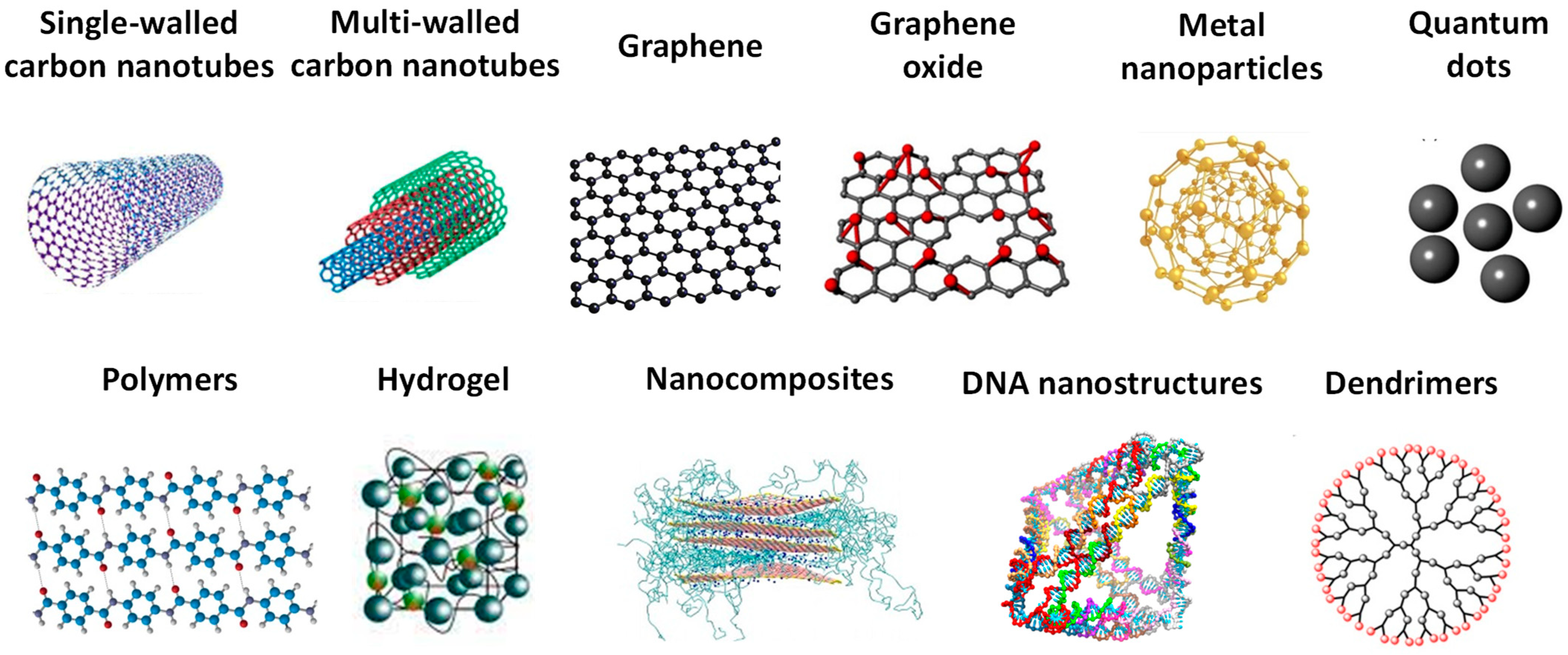

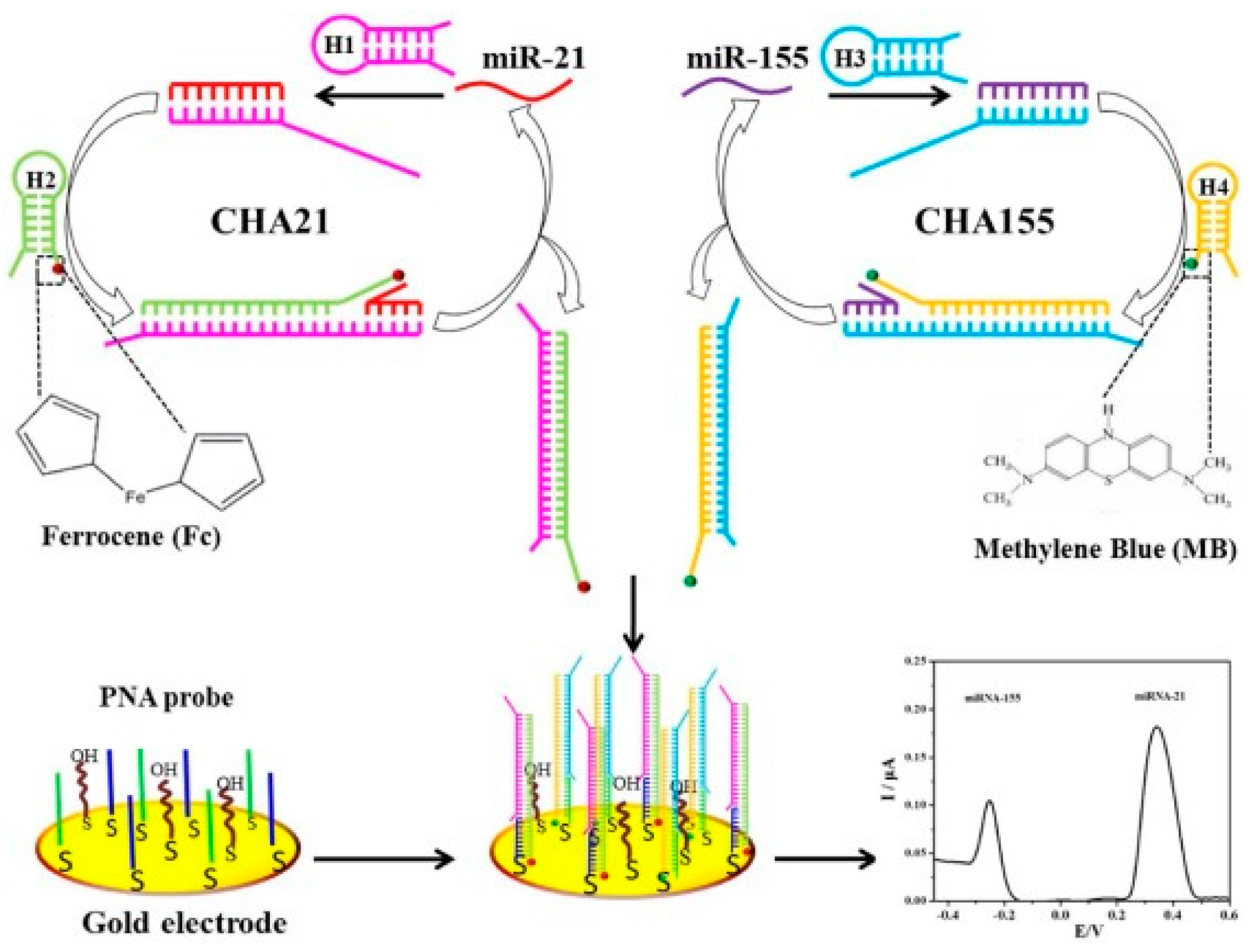
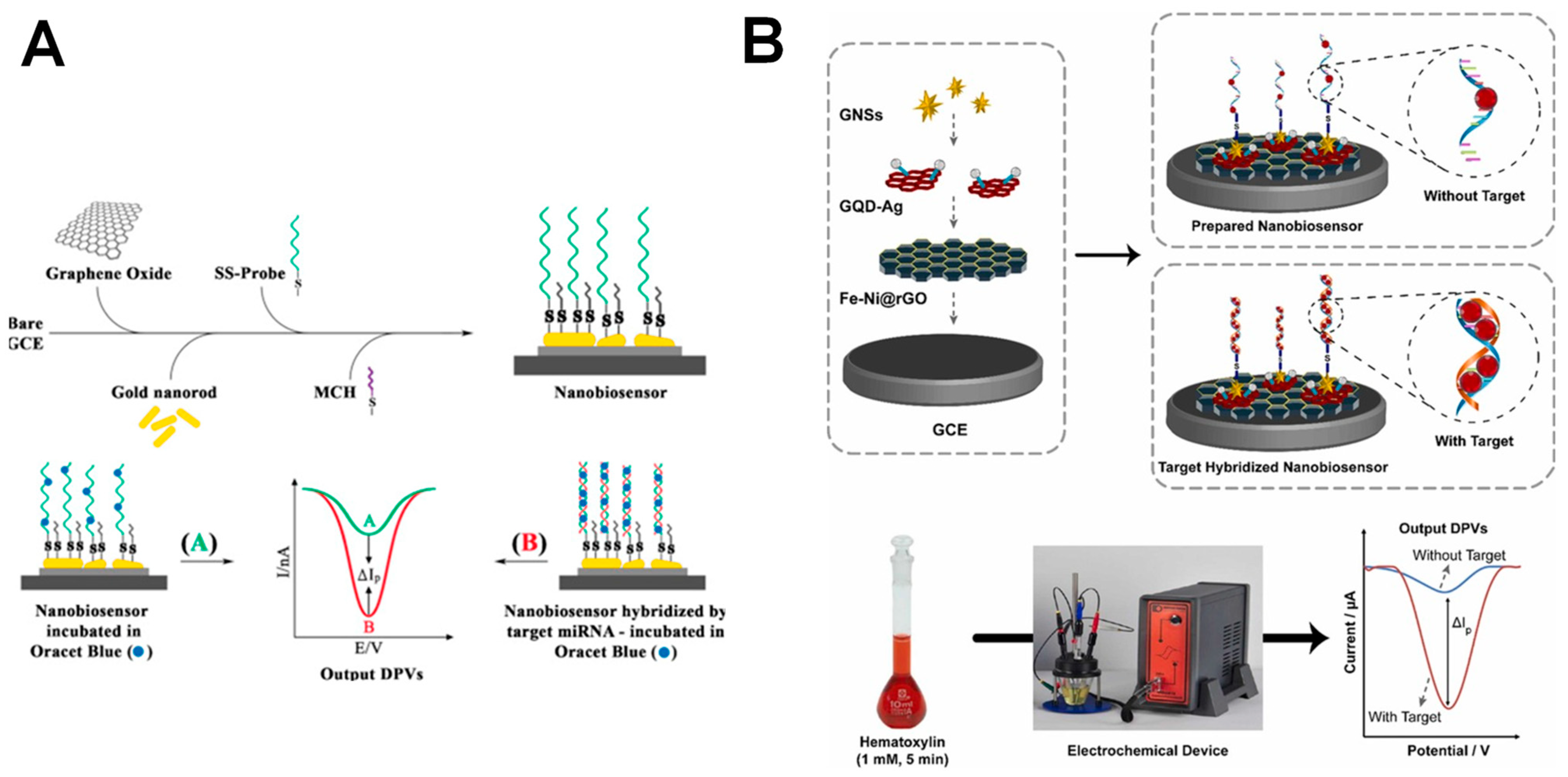
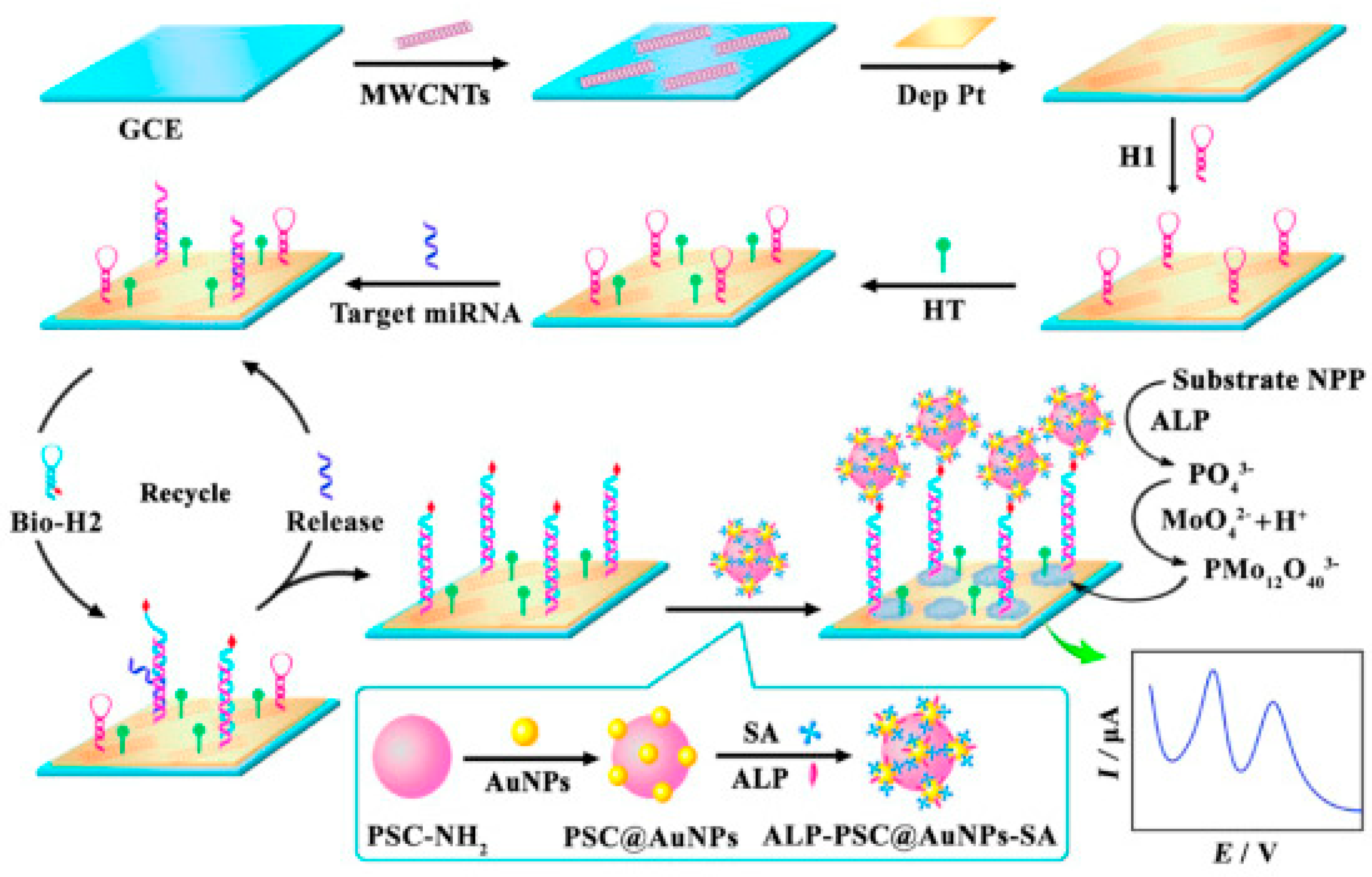

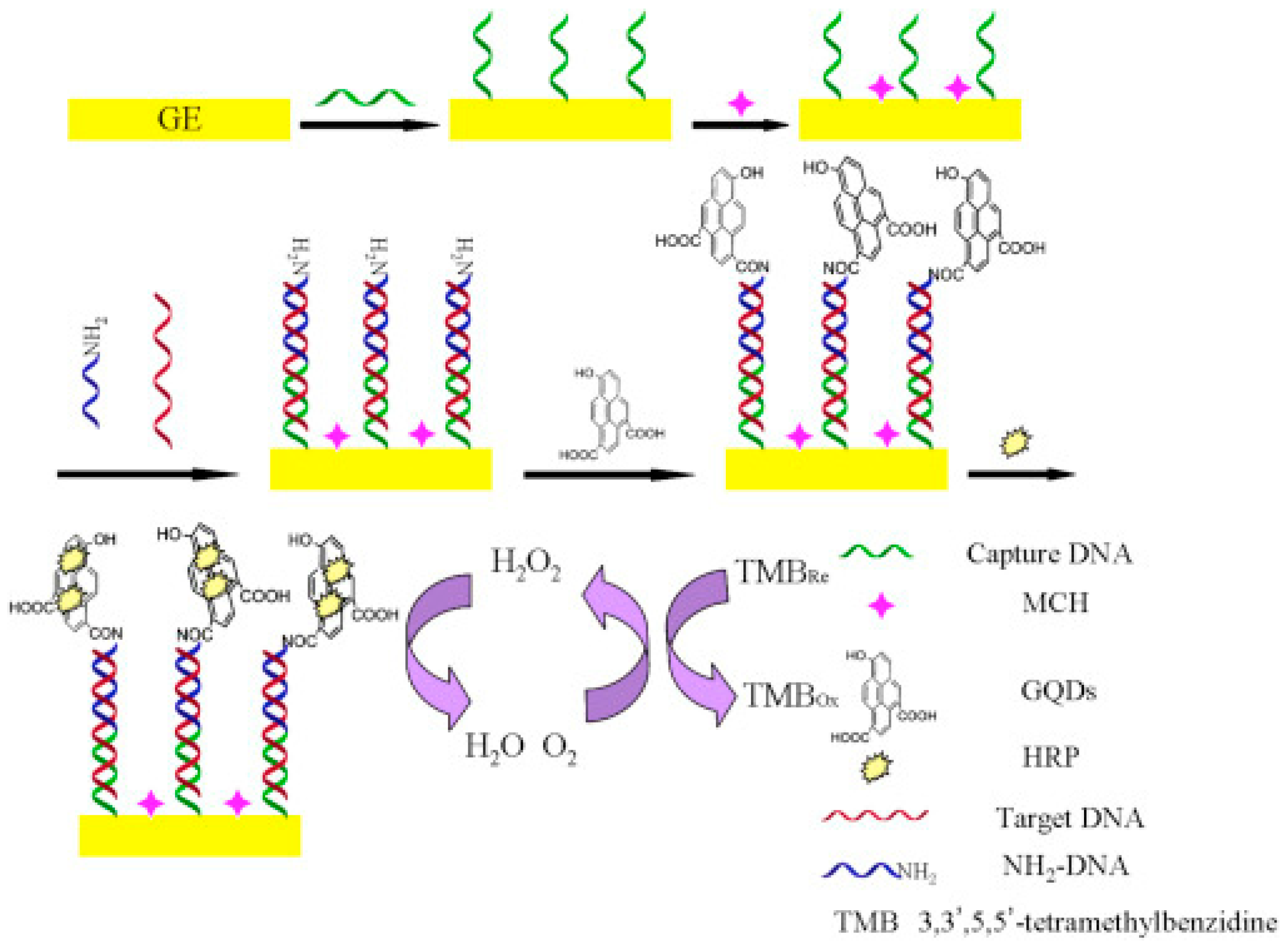
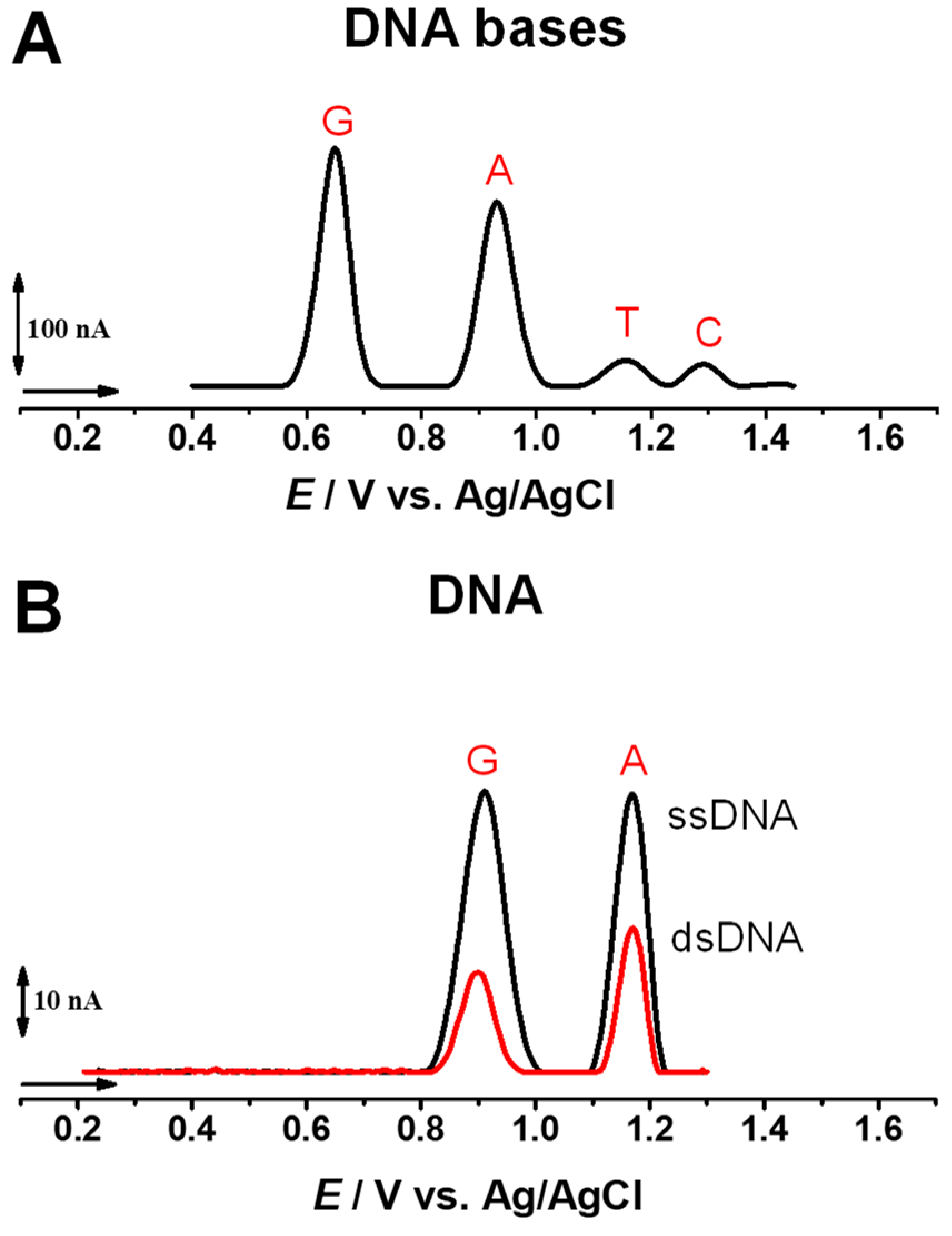
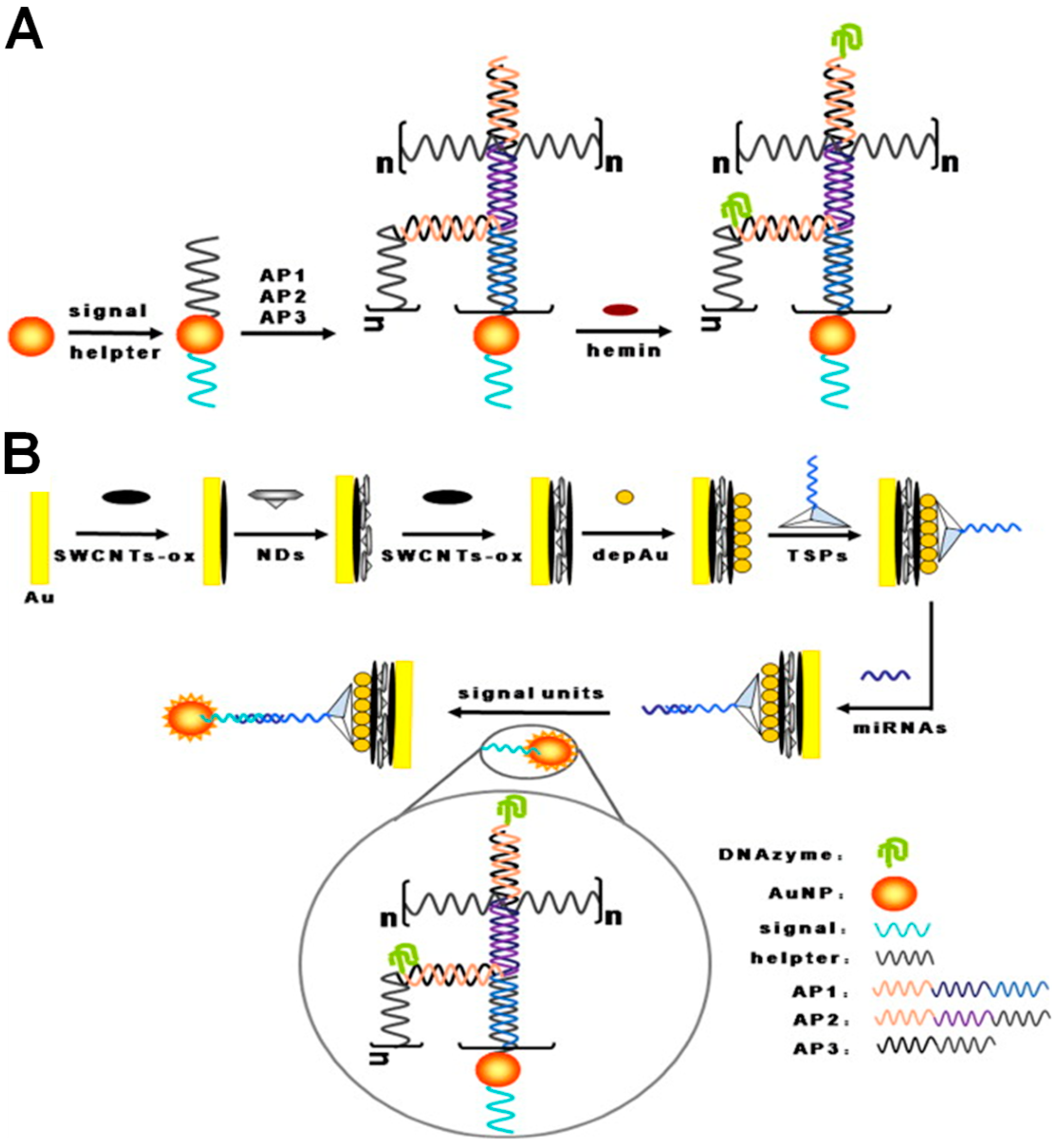

Disclaimer/Publisher’s Note: The statements, opinions and data contained in all publications are solely those of the individual author(s) and contributor(s) and not of MDPI and/or the editor(s). MDPI and/or the editor(s) disclaim responsibility for any injury to people or property resulting from any ideas, methods, instructions or products referred to in the content. |
© 2023 by the author. Licensee MDPI, Basel, Switzerland. This article is an open access article distributed under the terms and conditions of the Creative Commons Attribution (CC BY) license (https://creativecommons.org/licenses/by/4.0/).
Share and Cite
Chiorcea-Paquim, A.-M. Advances in Electrochemical Biosensor Technologies for the Detection of Nucleic Acid Breast Cancer Biomarkers. Sensors 2023, 23, 4128. https://doi.org/10.3390/s23084128
Chiorcea-Paquim A-M. Advances in Electrochemical Biosensor Technologies for the Detection of Nucleic Acid Breast Cancer Biomarkers. Sensors. 2023; 23(8):4128. https://doi.org/10.3390/s23084128
Chicago/Turabian StyleChiorcea-Paquim, Ana-Maria. 2023. "Advances in Electrochemical Biosensor Technologies for the Detection of Nucleic Acid Breast Cancer Biomarkers" Sensors 23, no. 8: 4128. https://doi.org/10.3390/s23084128






